Throughout history, wine has been a common thread running through innumerable cultures, religions, and nations. The global wine industry dates to antiquity, and though you probably think that women held no particular place in shaping it, you are wrong. In fact, according to science, women possess an advantage over men in the creation of wine: they have, on average, a better sense of both smell and taste. Over the past two centuries women played their significant part in shaping the wine industry and history. Let’s meet the most influential of them together!
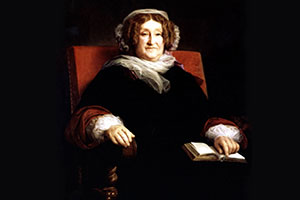 One of the most notable women of wine-making was La Veuve Clicquot, or the Widow Clicquot (1777-1866). Her name is still seen on the label of one of the most famous Champagne brands in the world. It is said that when her wine landed in Russia, Tsar Alexander announced that it was the only kind he would drink. Barbe-Nicole Clicquot, née Ponsardin, France’s first businesswoman, widowed in 1805 at the age of 27, took over her late husband’s wine business and turned it into a thriving wine house. Because she didn’t like the sediment that had traditionally clouded finished Champagne, she figured out how to expel the leftover gunk after the second fermentation that happened in the bottle: By slowly turning the bottles as they aged (turning the bottle by hand a quarter turn at a time for 4-6 weeks), she could gently coax the unwanted dead yeast into the neck of the bottle without being suspended into the wine and then easily remove it at disgorgement. Today that process is known as riddling, or remuage, and wine producing houses all over the world still use this technique, validating her own words: ‘The world is in perpetual motion, and we must invent the things of tomorrow. One must go before others, be determined and exacting, and let your intelligence direct your life. Act with audacity.’»
One of the most notable women of wine-making was La Veuve Clicquot, or the Widow Clicquot (1777-1866). Her name is still seen on the label of one of the most famous Champagne brands in the world. It is said that when her wine landed in Russia, Tsar Alexander announced that it was the only kind he would drink. Barbe-Nicole Clicquot, née Ponsardin, France’s first businesswoman, widowed in 1805 at the age of 27, took over her late husband’s wine business and turned it into a thriving wine house. Because she didn’t like the sediment that had traditionally clouded finished Champagne, she figured out how to expel the leftover gunk after the second fermentation that happened in the bottle: By slowly turning the bottles as they aged (turning the bottle by hand a quarter turn at a time for 4-6 weeks), she could gently coax the unwanted dead yeast into the neck of the bottle without being suspended into the wine and then easily remove it at disgorgement. Today that process is known as riddling, or remuage, and wine producing houses all over the world still use this technique, validating her own words: ‘The world is in perpetual motion, and we must invent the things of tomorrow. One must go before others, be determined and exacting, and let your intelligence direct your life. Act with audacity.’»
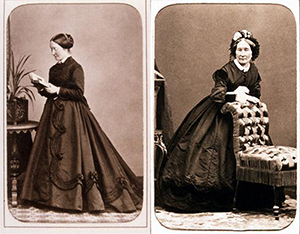 In exactly the same manner, at the age of 38, Louise Pommery (1819-1890) took over his husband’s place at the helm of their wine house, when the latter passed away. She’s credited for switching the focus of the company from still red wine to sparkling white wine. Louise created ‘Brut’ Champagne for Queen Victoria, a style that took the English market by storm when it was released. Though not a wine maker of her own, Queen Victoria, was still greatly influential in the global trade of wine; in the 1860s she had her travel director write to the famous Louise Pommery to request that 100 bottles be sent to the British embassy in Paris. It was served at the Queen’s table daily. We can also thank Pommery for creating wine tourism, by building an estate to accommodate guests traveling to the Champagne region of France.ς.
In exactly the same manner, at the age of 38, Louise Pommery (1819-1890) took over his husband’s place at the helm of their wine house, when the latter passed away. She’s credited for switching the focus of the company from still red wine to sparkling white wine. Louise created ‘Brut’ Champagne for Queen Victoria, a style that took the English market by storm when it was released. Though not a wine maker of her own, Queen Victoria, was still greatly influential in the global trade of wine; in the 1860s she had her travel director write to the famous Louise Pommery to request that 100 bottles be sent to the British embassy in Paris. It was served at the Queen’s table daily. We can also thank Pommery for creating wine tourism, by building an estate to accommodate guests traveling to the Champagne region of France.ς.
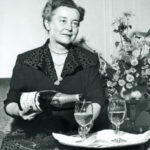 Elizabeth “Lily” Bollinger (1899-1977), also widowed at the age of 42, became head of the Bollinger House and one of the leading ladies of Champagne. She bravely – and successfully – led the company through the German occupation of WWII. In the 1970s, Bollinger became the official Champagne of the James Bond movies. You can catch her sparkling in Bond films featuring Roger Moore, Pierce Brosnan and Daniel Craig. Her most famous quote is one we could swear by: ‘I drink Champagne when I’m happy and when I’m sad. Sometimes I drink it when I’m alone. When I have company I consider it obligatory. I trifle with it if I’m not hungry and drink it when I am. Otherwise, I never touch it – unless I’m thirsty.’ Cheers to Lily!!
Elizabeth “Lily” Bollinger (1899-1977), also widowed at the age of 42, became head of the Bollinger House and one of the leading ladies of Champagne. She bravely – and successfully – led the company through the German occupation of WWII. In the 1970s, Bollinger became the official Champagne of the James Bond movies. You can catch her sparkling in Bond films featuring Roger Moore, Pierce Brosnan and Daniel Craig. Her most famous quote is one we could swear by: ‘I drink Champagne when I’m happy and when I’m sad. Sometimes I drink it when I’m alone. When I have company I consider it obligatory. I trifle with it if I’m not hungry and drink it when I am. Otherwise, I never touch it – unless I’m thirsty.’ Cheers to Lily!!

Portuguese Dona Antónia Adelaide Ferreira (1811-1896), nicknamed The Ferreirinha, believed that her country could produce great wines, despite the popularity, at the time, of imported wine from Spain. She traveled to England to learn about the most modern techniques used to fight phylloxera, a catastrophic louse that was devastating vineyards throughout Europe, as well as new skills for producing quality-minded wine. She then brought all of these skills back to her native Douro Valley and forever changed the trajectory of Port wine in the modern era. She is celebrated throughout the Portuguese wine trade for the belief and passion she carried through everything she fought to change and improve.
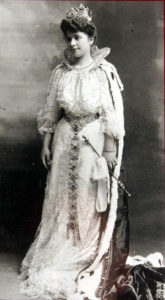 Legendary business woman, as well as one of the first female wine maker in the United States, Isabelle Simi’s (1886-1981) story started in 1904, at the age of just 18. She unexpectedly found herself in charge of the family’s business in Sonoma, California, when her father and uncle both died from a flu outbreak. She guided her family through saving their vineyards in the Great Earthquake of 1906 and managed to keep her winery afloat during prohibition, which put almost every winery in the country out of business. The family winery still exists today.
Legendary business woman, as well as one of the first female wine maker in the United States, Isabelle Simi’s (1886-1981) story started in 1904, at the age of just 18. She unexpectedly found herself in charge of the family’s business in Sonoma, California, when her father and uncle both died from a flu outbreak. She guided her family through saving their vineyards in the Great Earthquake of 1906 and managed to keep her winery afloat during prohibition, which put almost every winery in the country out of business. The family winery still exists today.
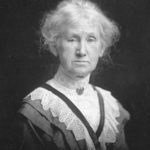
Another American, Hannah Weinberger, was the first female winemaker in the famous Napa Valley. Weinberger lead the winery of her husband John, after he was shot dead in March 1882. In 1889, she crossed the Atlantic to appear at the World’s Fair in Paris as the only California female vintner to win a silver medal in the wine competitions. Weinberger’s winery didn’t stand as lucky as Simi’s, being forced to closure during the 1920 prohibition. It would be nearly 50 years before California’s next female vintner rose to prominence.
 Madame Lalou Bize-Leroy (1932-present), known as The Grand Dame of Burgundy, was once a partner and guiding force at the now famous Domaine de la Romanée Conti. She left in the early 1990s to focus on her family’s namesake domaine. At a time while most of Burgundy was still using pesticides, herbicides and fertilisers, she believed in the practice of biodynamic farming, maintaining her viticulture practices even in disastrous years, like the mildew-ridden 1993 vintage. Those around her told her she was mad. It’s a good thing she stuck to her ploughs, because the 1993 vintage put her on the map and today Domaine Leroy’s wines are some of the most coveted and rare bottlings in the world.
Madame Lalou Bize-Leroy (1932-present), known as The Grand Dame of Burgundy, was once a partner and guiding force at the now famous Domaine de la Romanée Conti. She left in the early 1990s to focus on her family’s namesake domaine. At a time while most of Burgundy was still using pesticides, herbicides and fertilisers, she believed in the practice of biodynamic farming, maintaining her viticulture practices even in disastrous years, like the mildew-ridden 1993 vintage. Those around her told her she was mad. It’s a good thing she stuck to her ploughs, because the 1993 vintage put her on the map and today Domaine Leroy’s wines are some of the most coveted and rare bottlings in the world.
Most historians now agree that wine was most likely discovered by a woman. However, ancient stories of the goddesses of wine – most of who came into being centuries before Bacchus and Dionysus – are relatively unknown. Regardless of the birthplace of wine, it is a common belief that because women were involved in the gathering of grapes, it was most likely a woman who unwittingly invented wine. It is quite reasonable that the first gods of wine were women, as the oldest divinities were female agriculture goddesses of earth and fertility. The most ancient goddess of wine appeared in the Sumerian Empire, modern-day Iraq, and also in the ancient Indus manuscript, the Rig Veda. Her name was Gestin, meaning wine, vine, grape, and she was being worshiped as early as 3000 BC. Later, in 1500 BC, in the same geographical region, the wine goddess Paget appeared. References on clay tablets mention her as working in the vineyard, helping to make wine. In 1300 BC Egypt the wine goddess Renen-utet is mentioned on hieroglyphic tablets as blessing the wine. She is usually depicted as having a small shrine near the wine press, while her figure appeared on the spout where the grape juice flowed into the receiving tank. She would sometimes be joined by Ernutet, the Egyptian goddess of plenty, both blessing the grape harvest. Around 400 to 300 BC, as wine became more prominent in Sumeria, a new wine goddess, Siduri, the Maker of Wine appeared. She has been reported as welcoming heroes to a garden with the tree of life, which bears ruby red fruit with tendrils.
The connection between women and wine has robust roots in antiquity and has been steadily growing stronger, bearing new fruit, better harvests and indulgent wines.



